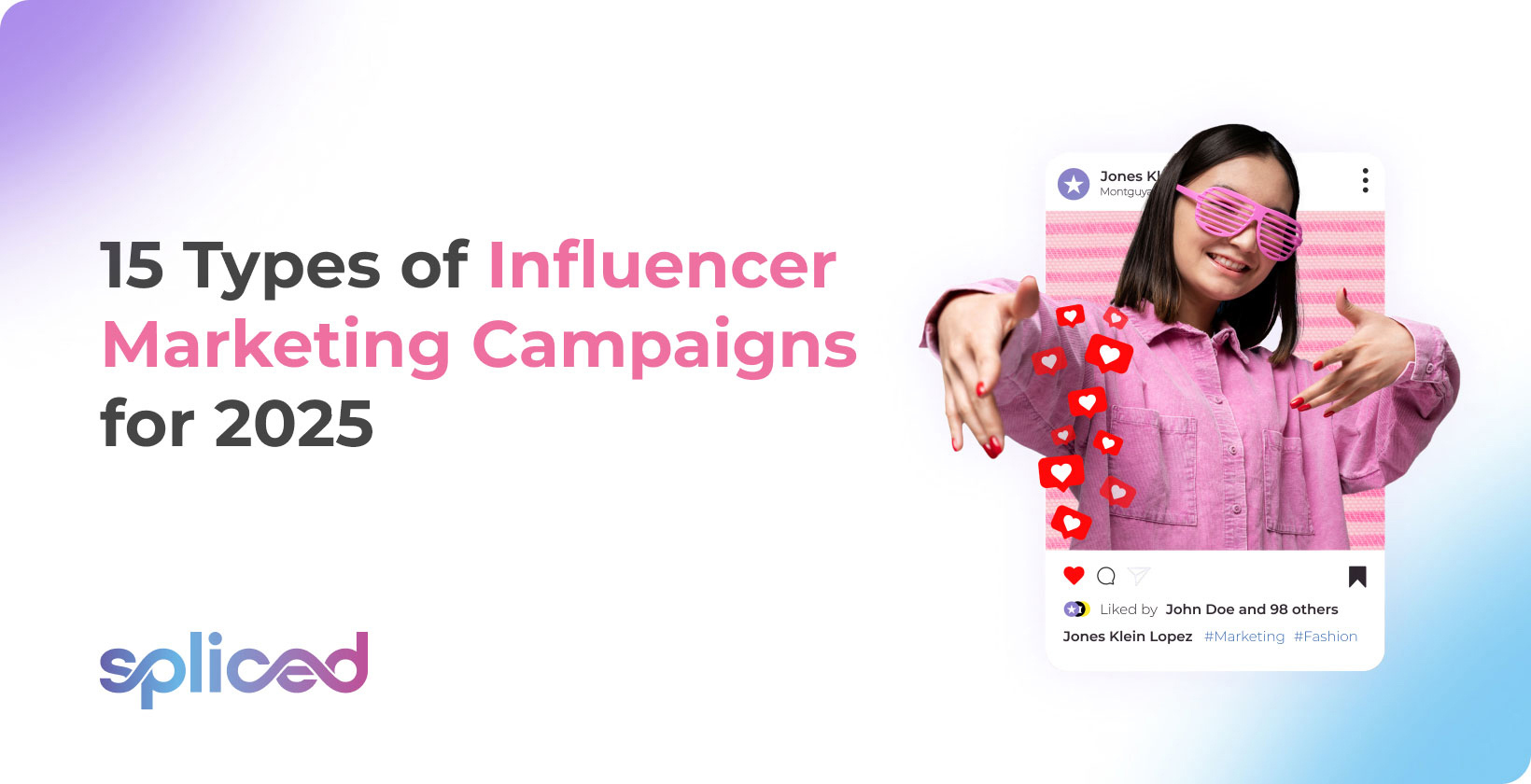Influencer marketing campaigns have emerged as dynamic and effective methods for connecting with audiences, boosting brand visibility, and fostering genuine engagement. Influencer marketing strategies involve partnerships between companies and people who have sway over a particular target demographic through their social media presence, content creation, and online authority. Influencer marketing has developed in 2025 to include a variety of creative and strategic techniques that are specifically suited to shifting tastes and consumer behavior.
Influencer marketing campaigns use relatability and authenticity to offer marketing messages that are easily incorporated into the influencer’s content. Brands leverage the unique relationship that influencers have with their followers through influencer marketing strategy, using their trust to boost brand recognition, generate engagement, and eventually inspire conversions. Influencer partnerships are an effective tool for generating credibility since the marketing strategy acknowledges that consumers frequently seek advice and endorsements from people they respect and trust.

The 15 types of influencer marketing campaigns shaping the marketing landscape in 2025 are listed below.
- Pre-Release Campaigns: Influencers create buzz and excitement among their followers by giving sneak peeks and insider knowledge before a product launch.
- Unboxing Videos: Influencers demonstrate items’ features and advantages in real-time while unboxing and reviewing them.
- Sponsored Blog Posts: Working with bloggers allows thorough product reviews, side-by-side comparisons, and instructive content, enhancing brand credibility and engagement.
- Host Brand Experience Events: Influencers plan one-of-a-kind gatherings that completely engulf their audience in the world of the brand to increase brand loyalty and develop emotional bonds.
- Branded hashtags: Creating hashtags that influencers use in their content to promote user-generated content helps the campaign gain more exposure and interaction.
- Content and Product Collaborations: Co-creating content or products with influencers produces genuine endorsements that resonate with the audience of the influencer.
- Giveaway Contests Such as Discount Codes: Influencers host giveaways and distribute discount codes to increase audience participation and sales.
- Sponsored Social Posts: Paid posts seamlessly integrate the brand’s message within an influencer’s existing content, capitalizing on their followers’ trust.
- Event Activations: Live or recorded occasions where influencers interact directly with the public to strengthen the bond between the brand and its fans.
- Guest Blog Posts: Influencers write guest pieces for brands’ blogs, adding their distinct opinions and extending the range of material the company offers.
- Affiliate Marketing: Influencers market goods using customized affiliate links, making money from each sale that results from using their channels.
- Reviews: Thorough evaluations from influencers offer knowledge and foster trust, assisting future buyers in making wise judgments.
- Shoutout Content: Influencers post succinct, strong recommendations on their social media platforms, compellingly introducing the business to their audience.
- Social Media Takeovers: Influencers temporarily taking over a brand’s social media accounts add new ideas and spark follower engagement and excitement.
- Brand Ambassadors: Long-term collaborations with influencers strengthen a brand’s identity, fidelity, and regular exposure to its committed audience.
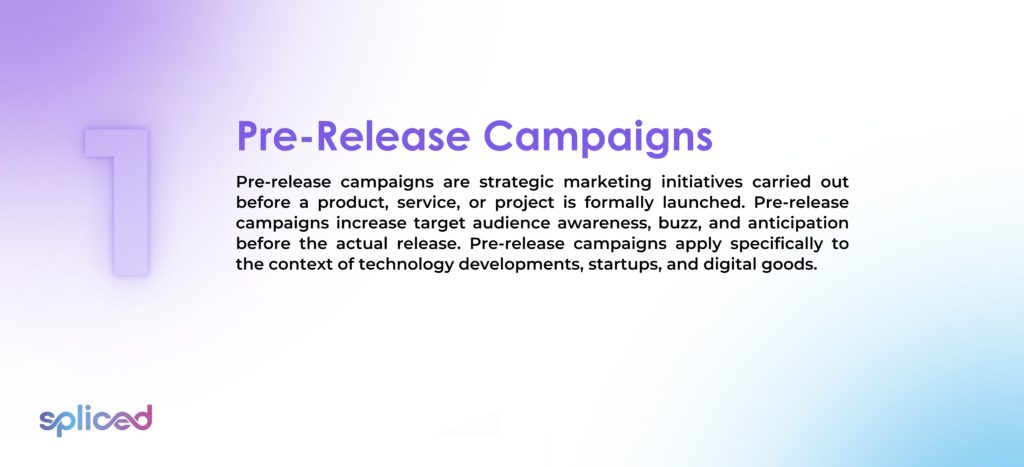
1. Pre-Release Campaigns
Pre-release campaigns are strategic marketing initiatives carried out before a product, service, or project is formally launched. Pre-release campaigns increase target audience awareness, buzz, and anticipation before the actual release. Pre-release campaigns apply specifically to the context of technology developments, startups, and digital goods.
Pre-release campaigns frequently include teaser content, sneak peeks, special access deals, and engaging interactive elements. They are intended to draw investors, enthusiasts, and early adopters eager to use the new product before anybody else.
Companies strategically reveal sneak peeks of the impending product’s features, advantages, and impact during pre-release marketing. Pre-release campaigns are accomplished using posts on social media, email newsletters, webinars, and specific landing pages. Pre-release campaigns want to guarantee a devoted user base even before the official debut by arousing interest and excitement.
Pre-release campaigns have several advantages. Pre-release campaigns enable businesses to test market interest and collect feedback from a small group of users before the main launch, allowing them to make necessary modifications. Pre-release campaigns help obtain initial finance and investments, giving the impending launch a financial boost. Effective pre-release efforts produce a sizable first user base, giving an advantage in the cutthroat market.
Pre-release campaigns raise interest and enthusiasm among the target audience by creating early buzz and awareness about the service. Pre-release campaigns make getting insightful comments from involved people easier, allowing early product improvements based on practical knowledge. Pre-release campaigns attract new investors and partners who are drawn to the creative concept, which is another significant advantage. Pre-release campaigns help create a dedicated user base by providing early information or access to ensure high initial user traction throughout the launch period.
For example, pre-release campaigns reach a small audience initially rather than drawing in a larger one. There are hazards related to competition because exposing features before launch gives rivals an opportunity to respond, contradict, or even copy features of the product. The risk of disappointment is the final significant disadvantage. Users get dissatisfied if the campaign’s execution falls short and the final product doesn’t live up to the promises made during the pre-release stage.
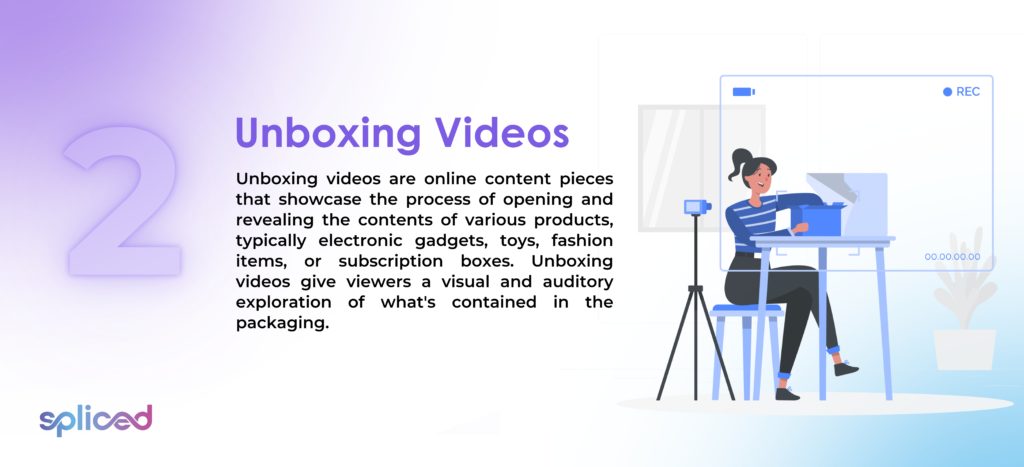
2. Unboxing Videos
Unboxing videos are online content pieces that showcase the process of opening and revealing the contents of various products, typically electronic gadgets, toys, fashion items, or subscription boxes. Unboxing videos give viewers a visual and auditory exploration of what’s contained in the packaging.
Unboxing videos involve opening a product’s package to disclose its contents, frequently with the creator’s commentary or narration. The unboxing process is depicted in various ways in unboxing videos, from simple to extensive presentations with additional information, reviews, and comments.
Viewers get a close-up view of a product’s packaging, design, bundled accessories, and overall presentation in unboxing videos. The creators go over the features, requirements, and first impressions of the product, which give viewers helpful information.
Creators record themselves opening the product’s packaging, talking about their feelings and observations as they look inside. Social media sites or platforms, such as YouTube are frequently used to share video content. Unboxing videos range from informal and conversational to professionally produced, depending on the creator’s choices and the audience’s tastes.
Unboxing videos provide viewers with a detailed look at a product before buying. Unboxing videos offer a practical viewpoint on the features and packaging of the product. Unboxing videos instruct and amuse viewers while educating them on the advantages and disadvantages of a product.
Unboxing videos offer clarity about products and a sense of anticipation and excitement, and they introduce viewers to new goods or companies. Unboxing videos assist viewers in making informed purchasing decisions. Unboxing videos foster a sense of belonging among viewers who have interests.
Unboxing videos provide first impressions, so they do not necessarily represent a product’s long-term performance or quality. Some unboxing videos are biased or sponsored, which results in false information. Overwatching unboxing videos promote impulsive purchases motivated more by aesthetic attraction than actual need.
For example, the unboxing of the most recent flagship smartphone was featured in a video entitled “The Latest Flagship Smartphone MONSTER,” posted on YouTube by a well-known tech reviewer. The beginning of the video shows the creator’s joy at receiving the package and describes its shipment and presentation. The gadget, accompanying accessories, and initial boot-up were carefully highlighted while the unboxing procedure was demonstrated. The creator shared their initial observations while commenting on the device’s appearance, display, camera arrangement, and other noteworthy aspects. The example shows how unboxing videos give viewers insightful information on the packaging, contents, and general user experience of a product.
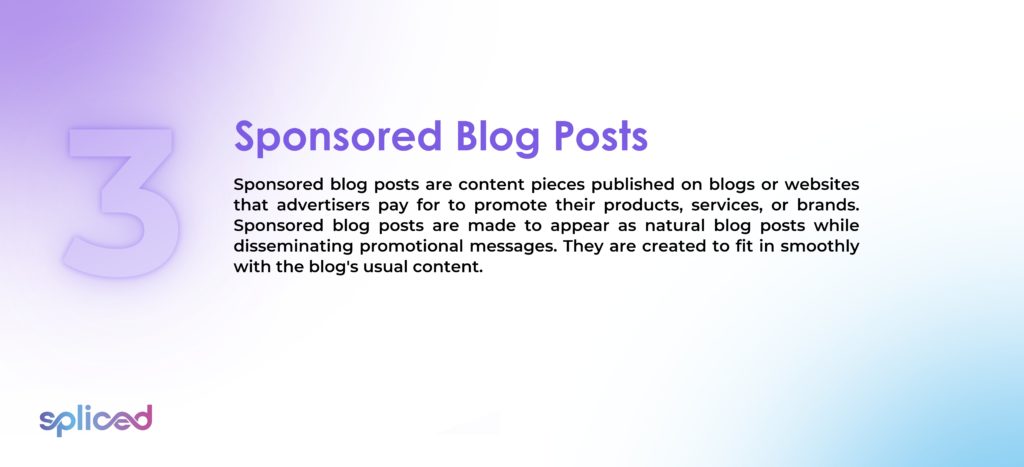
3. Sponsored Blog Posts
Sponsored blog posts are content pieces published on blogs or websites that advertisers pay for to promote their products, services, or brands. Sponsored blog posts are made to appear as natural blog posts while disseminating promotional messages. They are created to fit in smoothly with the blog’s usual content.
Sponsored blog posts are written with the help of marketers and writers to engage the blog’s audience with content that gently markets goods or services. The capacity of sponsored blog posts to deliver exciting and engaging information about the sponsor’s offerings that appeals to the blog’s target audience is their crucial component.
Bloggers who have a relevant readership work with advertisers. The bloggers create content that incorporates the sponsor’s message into their usual publishing approach. Advertisers take advantage of the blogger’s popularity and authority through sponsored blog articles to increase brand recognition and trust. Bloggers gain from monetary rewards or other incentives, which complement their income and support their efforts to produce content.
Advertisers reach niche audiences with genuine, content-driven promotion in sponsored blog articles. They give bloggers a way to monetize their work and increase reader engagement with useful, pertinent information.
Sponsored blog posts are effective, but sometimes they must be clearer between editorial content and advertising to compromise the blog’s credibility. Promotional information that is not handled carefully risks turning away readers.
For example, consider collaborating with a luggage company as a travel blogger. The blogger includes the bag company’s goods as necessary resources for planned trips in a post titled “15 Packing Tips for Stress-Free Travels.” The example shows how a sponsored blog post delivers insightful information while quietly promoting the sponsor’s products.
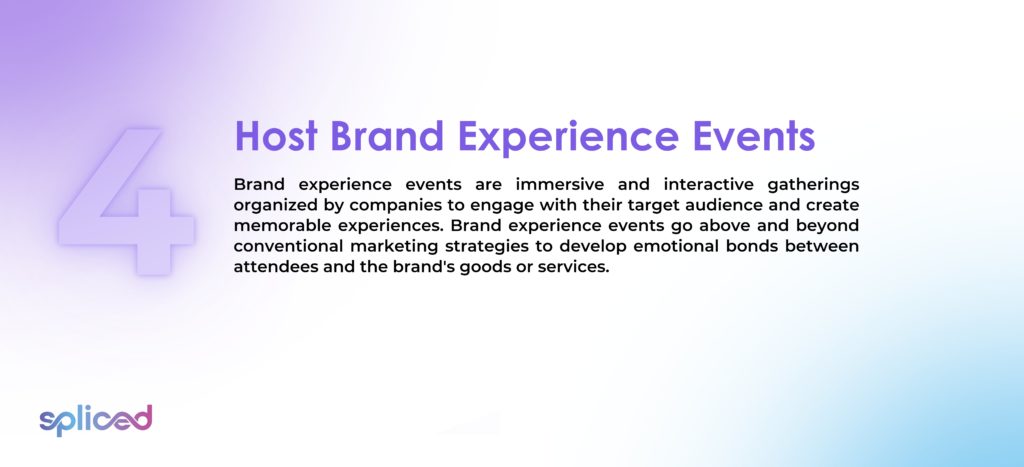
4. Host Brand Experience Events
Brand experience events are immersive and interactive gatherings organized by companies to engage with their target audience and create memorable experiences. Brand experience events go above and beyond conventional marketing strategies to develop emotional bonds between attendees and the brand’s goods or services. The focus is on providing participants with an up-close and personal experience with the brand’s values, culture, and products.
Brand experience events strongly emphasize experiential engagement, displaying the brand’s personality and products through practical activities, live performances, and one-on-one conversations. They frequently combine entertainment, storytelling, and education elements to produce a memorable multi-sensory experience for the audience.
Companies choose the best locations for brand experience events, create interactive displays, create captivating content, and seamlessly include their goods or services in the event’s activities. Participants are encouraged to actively engage, which helps them emotionally relate to the brand’s concept and services.
Brand experience events have several benefits. They generate favorable associations, increase brand loyalty, and make an enduring impression on attendees. Companies receive feedback and get essential insights into consumer preferences by providing direct connections. Brand experience events result in discussion and social media coverage, increasing the brand’s organic reach.
Brand experience events have several benefits. Brand experience events help the brand and its audience develop strong emotional bonds that strengthen their relationship and commitment. Brand experience events improve memorability since attendees recall their immersive experiences, which enhances brand memory when consumers make purchases. The engagement component is essential because interactive activities at brand experience events attract guests and keep them engaged and excited throughout. Direct interactions have the advantage of prompt feedback, allowing businesses to learn how to develop products based on customers’ replies in real time.
Hosting brand experience events has its share of difficulties. The associated costs are the main worry. Brand experience events are expensive to plan, involving costs for venue rental, production, staffing, and several other logistical components. Large-scale event planning and execution involve careful consideration of logistics and coordination, which are resource-intensive. Their scope is limited by the number of participants, excluding a larger audience that benefits from the experience even though such events foster meaningful connections.
Apple’s yearly launch events are an illustrative example of a brand experience event. Apple’s events involve immersive demonstrations of new devices, software updates, and services. Participants explore the brand’s design philosophy, connect with specialists, and receive hands-on experience with the latest items. Apple events give its consumer base a sense of community in addition to raising anticipation. Apple’s events reinforce the company’s focus on user experience, building brand loyalty, and setting standards for engaging product launches.
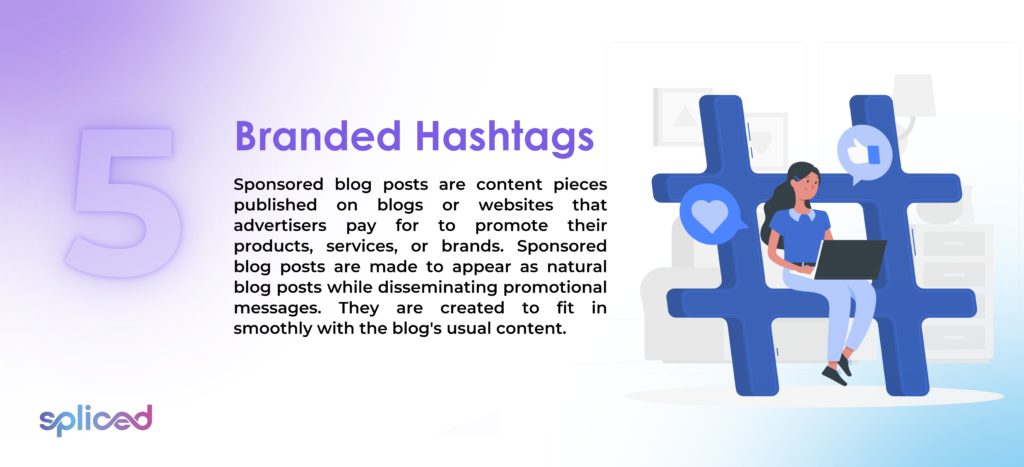
5. Branded Hashtags
Branded hashtags are specific and unique ones created to represent a brand, campaign, or product. Branded hashtags function as a tool for classifying and arranging information about the brand or campaign. Branded hashtags are frequently used to foster a sense of community and participation around a specific theme, making it simple for people to find and participate in conversations, promotions, or events related to the brand.
Custom hashtags companies or organizations make to develop a distinctive online presence and entice consumers to interact with their content are known as “branded hashtags.” Branded hashtags are frequently linked to the business’s name, tagline, marketing strategy, or item, making recognizing and following conversations around the brand simpler.
Branded hashtags help to highlight important information by grouping relevant content. Users quickly access a tailored selection of posts pertinent to a particular topic, message, or promotion by searching for or clicking on a branded hashtag. Branded hashtags make it easier to spread important messages and ensure that essential details are quickly found in social media content.
An audience is encouraged to use branded hashtags when a brand introduces them in their social media posts. Users that are using branded hashtags add to the increasing body of content linked to that hashtag. Examples of such content include customer feedback and reviews, promotional materials, and event announcements. The brand’s reach expands as consumers interact with the hashtag, generating a sense of community and loyalty.
Branded hashtags have several advantages. Branded hashtags expand the reach of marketing efforts, increase user interaction, and improve brand visibility. Brands build a more powerful online community by enticing people to participate in discussions using a common hashtag. Individuals interested in specific brand-related themes speed up their content discovery by using branded hashtags.
Branded hashtags offer a way to monitor and evaluate the efficacy of marketing initiatives. Engagement metrics empower brands to discern user sentiment, monitor trends, and evaluate the impact of campaigns. Branded hashtags become viral when they are effective, creating a significant buzz and naturally raising brand recognition.
The effectiveness of branded hashtags depends on user uptake and engagement. The hashtag’s intended impact arises if users reject it or choose not to use it. Managing a branded hashtag necessitates continuous observation to deal with any defamatory or irrelevant content that appears.
Coca-Cola’s #ShareACoke campaign is an outstanding illustration of a successful branded hashtag. The company replaced the logo on its soda bottles with famous names and encouraged customers to share photos using the hashtag. The campaign encouraged user-generated material while fostering individualized connections and product-related stories. The hashtag produced plenty of user engagement and was widely used, successfully demonstrating the effectiveness of branded hashtags in modern marketing techniques.
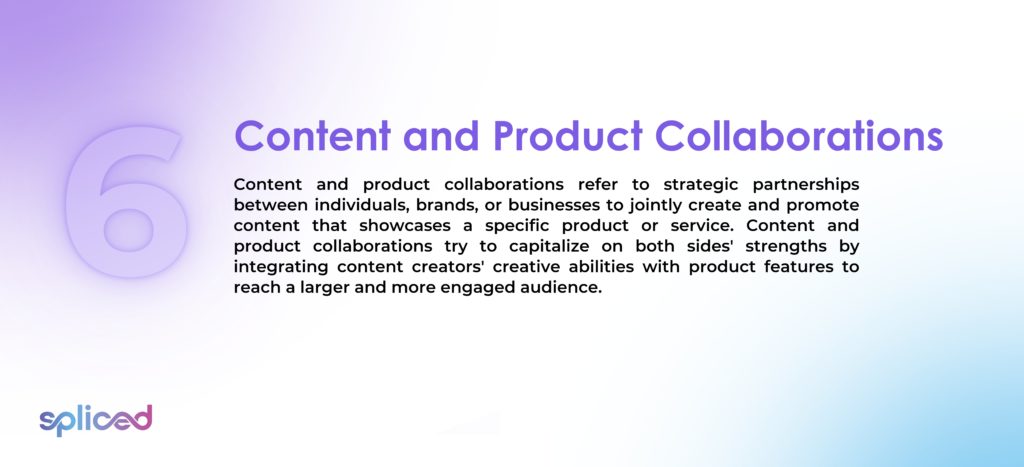
6. Content and Product Collaborations
Content and product collaborations refer to strategic partnerships between individuals, brands, or businesses to jointly create and promote content that showcases a specific product or service. Content and product collaborations try to capitalize on both sides’ strengths by integrating content creators’ creative abilities with product features to reach a larger and more engaged audience.
Content and product collaborations emphasize the interplay between the advertising of products and content creation. They involve aligned audiences, shared objectives, and cross-promotion. The produced content comes in various formats, such as blog entries, films, social media campaigns, or podcasts. All of the mediums to produce content are intended to showcase the product’s value proposition.
Collaborations on content and products frequently start with brainstorming meetings to match messaging, target audience, and content type. Content creators seamlessly incorporate the product into their work, exhibiting its benefits organically. Cross-promotion is a common aspect of the partnership, in which each party advertises the content on their own channels to increase visibility.
Content and product collaborations have several advantages. Brands obtain true promotion from the content creator’s honest support, which builds trust and credibility. Real-world product integration allows content creators to reach new audiences, receive compensation, and enhance the value of their content. Audiences gain from educational and entertaining content while discovering beneficial items or services.
The wider exposure of content and product collaborations is one important advantage since both parties are exposed to a bigger and more varied audience. Genuine endorsements from content producers help to strengthen the brand’s legitimacy, which is quite helpful in gaining the trust of buyers. Content and product collaborations enable captivating content creation that encourages improved audience participation and increases brand and product recall. An opportunity for mutual growth develops as both parties grow the number of their subscribers, customers, or followers while utilizing one another’s advantages for group success.
Content and product collaborations convey certain difficulties. Keeping the brand’s identity and the content creator’s style and message in sync is difficult, requiring careful coordination to minimize discrepancies. A problem develops if the brand’s and the content creator’s target audiences are incompatible, resulting in poor promotion because the message does not resonate with the target demographic. Authenticity difficulties arise if the product integration feels forced or artificial inside the content, leading to audience distrust.
For example, a popular fitness influencer collaborates with a sports nutrition firm to produce training videos featuring the company’s protein supplements. The influencer creates exercise plans that incorporate the advantages of the goods, showing how they improve performance and recuperation. The influencer’s captivating videos draw in their fitness-focused audience while exposing the nutrition brand to a new market. The influencer and the brand promote the videos on their channels, raising awareness of the influencer’s content and the items. The partnership benefits the influencer by selling their material and giving their followers useful information. The endorsement of the influencer simultaneously increases the nutrition company’s visibility and reputation, which results in an increase in customers.
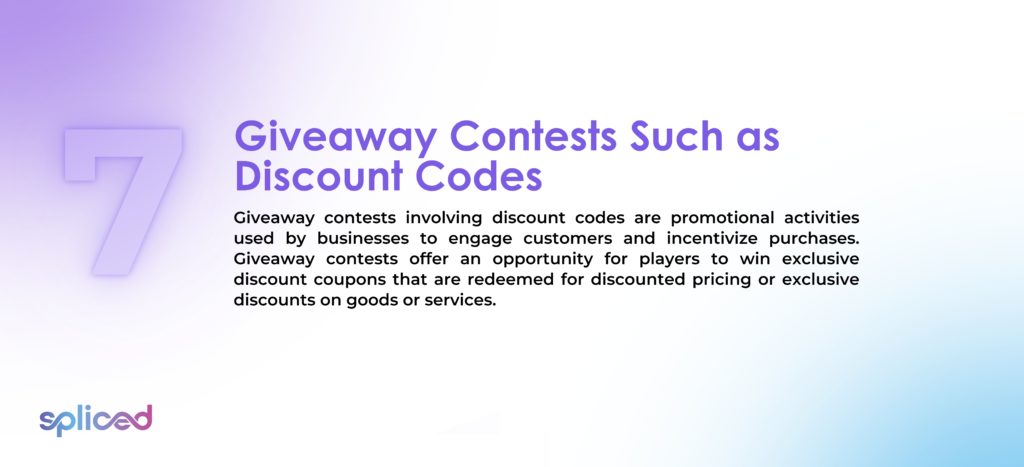
7. Giveaway Contests Such as Discount Codes
Giveaway contests involving discount codes are promotional activities used by businesses to engage customers and incentivize purchases. Giveaway contests offer an opportunity for players to win exclusive discount coupons that are redeemed for discounted pricing or exclusive discounts on goods or services.
A giveaway contest with discount codes entails giving participants a chance to win promotional codes that enable them access to discounts or special offers on a company’s offerings. Discount codes are applied during the checkout process to receive the perks listed.
Participants in such competitions enter by adhering to predetermined rules, such as liking, retweeting, or commenting on social media posts, signing up for newsletters, or making purchases. Winners are chosen randomly or based on a set of criteria, and they are given special discount codes that carry varying levels of discount percentages or exclusive offers.
Giveaway contests involving discount codes are used by businesses to increase brand recognition, draw in new clients, appreciate devoted customers, and create excitement about their goods and services. Giveaway contests promote client engagement and increase sales in a condensed amount of time by generating excitement and urgency.
Giveaway contests expand the brand’s social media reach and encourage consumer interaction and loyalty attracting new customers. Giveaway contests boost sales at the moment and collect information for the next marketing plans depending on participant preferences and behavior.
Giveaway contests involving discount codes are affordable marketing strategies that boost revenue and broaden a business’s clientele. They develop a strong bond between the company and its clients by evoking a feeling of anticipation and exclusivity.
Giveaway contests draw participants who are solely interested in discounts, even though they are effective, without necessarily fostering long-lasting relationships with the business. Managing the contest’s logistics and guaranteeing fair winner selection is difficult.
For example, a social media giveaway contest is launched by an online fashion company, allowing participants to win custom discount vouchers. The post must be liked, the participant must follow the page, and two friends must be mentioned in the comments for entry. Five winners are chosen randomly from among all participants, and each is sent a special discount code through a direct message by the retailer. Winners receive a free accessory and a 30% discount on their subsequent purchases when they use the codes. The giveaway increases engagement significantly, attracts new followers, and ultimately boosts sales of the retailer’s most recent line of merchandise.
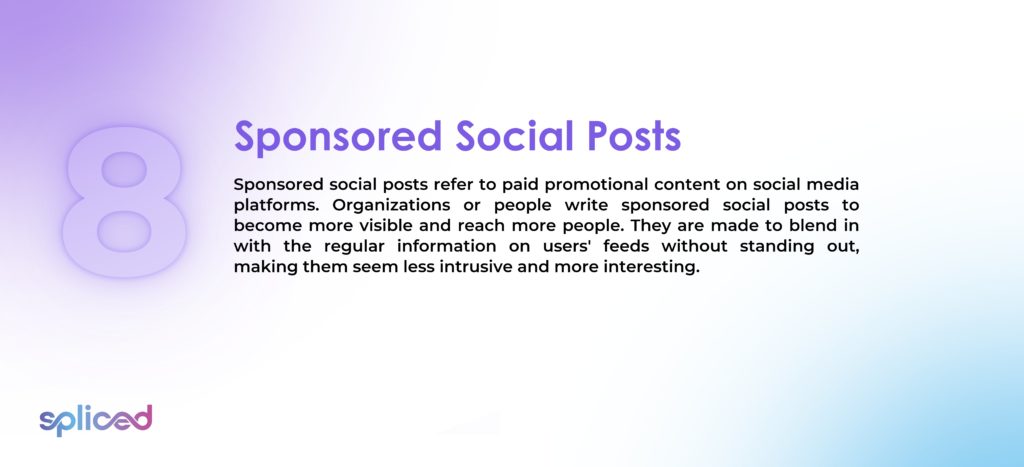
8. Sponsored Social Posts
Sponsored social posts refer to paid promotional content on social media platforms. Organizations or people write sponsored social posts to become more visible and reach more people. They are made to blend in with the regular information on users’ feeds without standing out, making them seem less intrusive and more interesting.
Sponsored social posts are sponsored adverts that appear as organic content in users’ social media feeds. The posts strive to draw attention to important information regarding goods, services, occasions, or projects, making sure that the main points are successfully communicated to the intended audience.
Businesses work with social media sites to make sponsored postings. Users that meet their defined target demographic and interest criteria are shown the posts by the platform. Sponsored social posts include text, photographs, or videos, and they show in the same place as regular updates from friends or accounts that users follow.
Sponsored social posts provide a way to raise company awareness, engagement, and sales. They use the platform’s user data to precisely target the desired audience, boosting the advertisement’s impact.
Sponsored social posts are placed carefully within users’ social media feeds to greatly boost people’s chances of noticing them. The ability to carefully target particular demographics guarantees that the information is consumed by people most likely to find it interesting and relevant. Users engage with sponsored posts through likes, comments, and shares due to the engaging nature of the high-quality material, promoting natural interaction and brand exposure. Businesses make data-driven adjustments due to the analytics offered by platforms, which give them useful information about the effectiveness of their sponsored postings.
The skepticism of consumers is one such obstacle, as some individuals view sponsored content as lacking in authenticity and being excessively promotional. Continuous exposure to sponsored content results in ad fatigue, which makes viewers uninterested or frustrated by the overwhelming amount of advertising. The money needed for sponsored posts must be considered because they do not always produce the intended effects. The smooth integration of the postings is not guaranteed across all social media platforms, which jeopardizes the effectiveness of the promotion and the overall user experience.
For example, a fitness company is launching a fresh collection of athletic clothing. They work with a social media platform to make sponsored posts with athletes from the sports world exhibiting the performance advantages of the gear to promote the launch. Sponsored social posts smoothly integrate into users’ feeds, catering to fitness aficionados between 18 and 35. The postings highlight the clothing’s technical attributes, such as its moisture-wicking fabric and ergonomic design, to increase engagement and conversions among the brand’s target market.

9. Event Activations
Event activations refer to strategic marketing efforts designed to create memorable and engaging experiences around specific events, occasions, or milestones. Event activations seek to engage the target audience by creating one-of-a-kind, immersive experiences that have an impact.
Event activations entail the creation of creative and engaging experiences targeted to a specific event, such as product launches, festivals, trade exhibitions, or corporate gatherings. The interactions go beyond conventional advertising strategies and emphasize creating buzz and enthusiasm through active participation.
Event activations strongly emphasize experiential marketing to foster strong emotional bonds between consumers and businesses. They frequently include interactive exhibitions, technology-driven engagements, and sensory stimuli to stand out in a congested marketing scene.
Planning and imagination are essential for successful event activations. Brands create installations, activities, performances, and workshops to complement the event’s topic and reflect their corporate identity. The interactions encourage active participation from visitors, building a stronger bond with the company. The noise generated during event activations spreads the brand message through word-of-mouth, social media sharing, and traditional press.
Event activations have several benefits, such as improved customer engagement, elevated brand visibility, and the opportunity to forge enduring memories. They make it easier for consumers and brands to interact directly, which fosters loyalty and trust. Event activations set a company apart from rivals by providing memorable, shareable experiences that appeal to customers.
Event activations give companies an opportunity to present their goods and services in a real-world setting. Event activations offer a platform for gathering data and real-time feedback, which helps to improve marketing campaigns. Event activations increase social media engagement because participants are eager to share their experiences online, broadening the brand’s appeal.
Event activations have a big payoff, but they take a lot of effort in terms of creativity, time, and resources. A successful activation is difficult to plan and carry out, and there is a risk that the intended impact does not materialize. Some activations come out as manufactured or insincere, which harms brand perceptions.
For example, a well-known athletic shoe manufacturer releases a new range of running shoes aimed at fitness fans. The brand is developing an event activity for an upcoming city marathon called the “Tech-Run Challenge.” They set up an interactive exhibit at the marathon expo where participants test the comfort and performance of the new shoes using a virtual reality (VR) running simulation. The quickest virtual marathon time is awarded, and the victors get a pair of new shoes. The activation attracts many people to the expo in terms of foot traffic and creates a buzz on social media as people share their VR experiences and show enthusiasm for the new shoe line. The company stands out as innovative and dedicated to boosting runners’ experiences due to the unique activation, which increases sales.
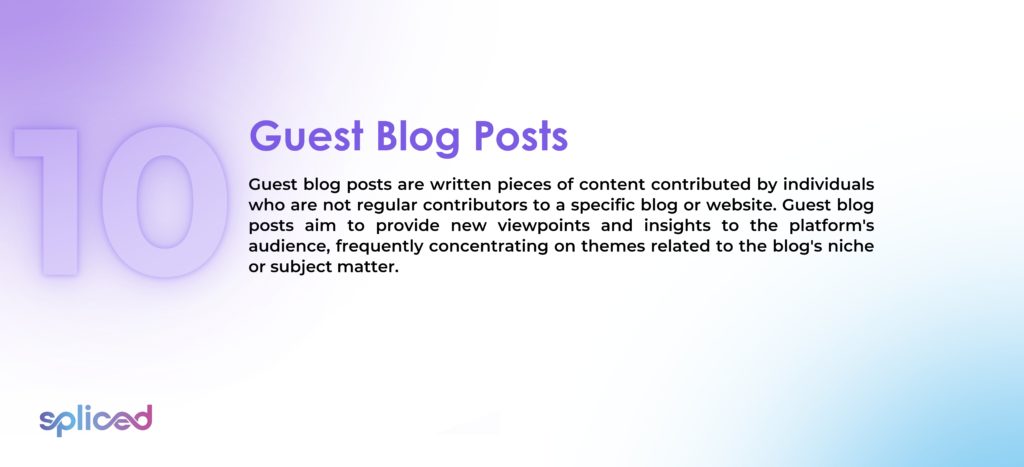
10. Guest Blog Posts
Guest blog posts are written pieces of content contributed by individuals who are not regular contributors to a specific blog or website. Guest blog posts aim to provide new viewpoints and insights to the platform’s audience, frequently concentrating on themes related to the blog’s niche or subject matter.
Guest blog posts allow experts, professionals, or hobbyists to share their expertise, experiences, and points of view with a larger audience. Guest blog posts provide an opportunity to highlight other viewpoints and keep a blog’s content flowing dynamically, ultimately enhancing the quality of the content as a whole.
Blog owners welcome guest authors to submit work, including guidelines, preferred topics, and submission conditions. A guest post is reviewed and edited by the blog’s editorial staff once it is submitted. The post is published after receiving approval, with the guest author receiving the proper credit. The blog and the guest author gain from the collaboration since it broadens their readership and gives them more exposure.
Bloggers and experts work together and network within a niche community by using guest blog articles to cross-promote and share audiences. Bloggers and experts boost a blog’s credibility and authority by showcasing varied opinions and connecting with industry leaders. Guest posts enhance traffic to the hosting blog and the website of the guest author, enhancing the brand’s visibility and search engine rankings.
Guest blog posts offer a variety of opinions, broadening subjects. Collaboration is facilitated by developing ties with guest authors, which improves networking and industry contacts. High-quality guest posts boost traffic and aid SEO by creating backlinks. Guest blog posts help to keep a steady posting schedule and content balance, even when one has a creative block.
Maintaining content quality in considering variations is difficult when using guest blog posts. Relevance is essential since content must fit the blog’s topic and captivate the existing readership. It takes time to review and coordinate guest posts, and there is an opportunity that contributions are irrelevant or spammy. Balancing guest posts with in-house content necessitates careful planning to keep the blog’s coherence.
For example, a famous fashion designer contributes a guest post to a site focusing on fashion, outlining the newest trends for the coming season. The blog’s fashion-conscious audience appreciates the post’s insights into color schemes, fabric selections, and style inspirations. The guest post enhances the blog’s content and encourages participation in the fashion industry while showcasing the designer’s experience and providing readers with useful information.
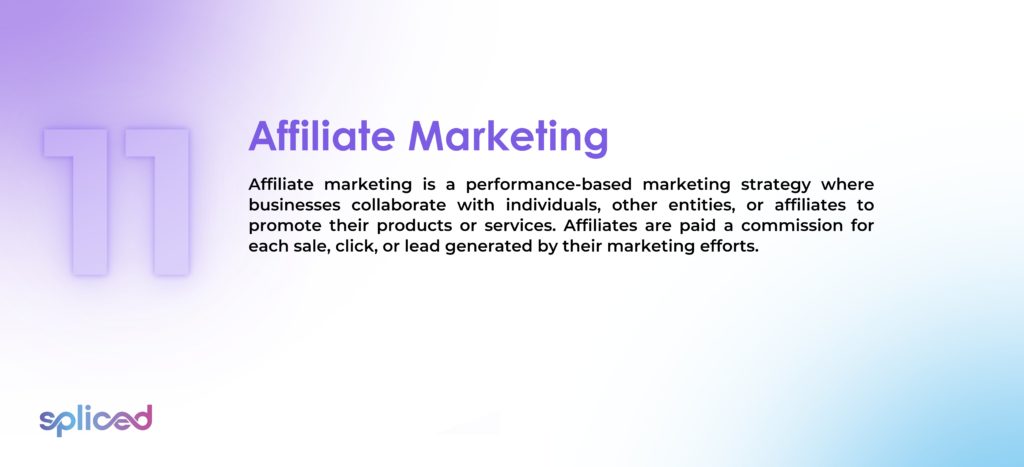
11. Affiliate Marketing
Affiliate marketing is a performance-based marketing strategy where businesses collaborate with individuals, other entities, or affiliates to promote their products or services. Affiliates are paid a commission for each sale, click, or lead generated by their marketing efforts. Affiliates monetize their online platforms and audiences by recommending pertinent items or services, and it is a win-win situation that allows businesses to grow their reach without having to pay upfront marketing expenses.
Affiliates enroll in affiliate programs offered by companies in affiliate marketing. Affiliates receive specific tracking links or codes to embed in their content, such as blogs, websites, social media posts, or videos. The affiliate is recognized for the referral and receives a commission by the affiliate program’s predefined rules when a user clicks on the links, purchases anything, or takes another desired action.
Businesses and affiliates gain from affiliate marketing in several ways. Businesses reach a larger audience without paying upfront advertising and solely pay commissions after successful transactions. Affiliates select products or services that align with their niche or target audience’s interests and monetize their web presence without developing their own goods.
Affiliate marketing is inexpensive since businesses pay for results. Scalability allows affiliates to market various products to a range of customers. The technique offers low entry barriers for anyone to become an affiliate while enhancing brand exposure and providing access to many platforms. Affiliates earn even during periods of inactivity because of passive revenue opportunities.
Affiliate marketing has benefits, but there are drawbacks. Standing out is challenging in some markets due to saturation. Businesses that depend on affiliates have dependence problems, and maintaining quality control is difficult. The risk of fraud through immoral means threatens the trust between companies, affiliates, and customers.
For example, a YouTube beauty influencer provides skincare product reviews. They sign up for a skincare company’s affiliate program. They receive particular tracking links from the brand. The influencer makes videos reviewing the products for the brand and inserts affiliate links in the caption of the videos. The influencer gets paid when viewers click on links and buy anything. The brand obtains visibility to the influencer’s audience through affiliate marketing as a result, and the influencer receives a cut of the sales they helped to generate.
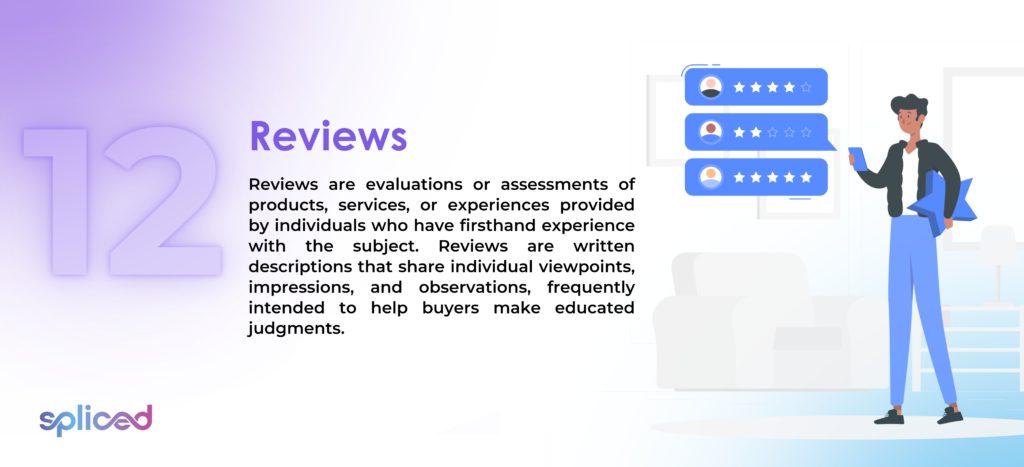
12. Reviews
Reviews are evaluations or assessments of products, services, or experiences provided by individuals who have firsthand experience with the subject. Reviews are written descriptions that share individual viewpoints, impressions, and observations, frequently intended to help buyers make educated judgments.
Reviews are written or spoken assessments that provide opinions and insights about a certain good, service, or encounter, usually based on a person’s own experience. Reviews emphasize crucial elements, including quality, performance, features, and user experience. Reviews are designed to give customers a thorough idea of what to expect from a good or service.
Reviews are written by product or service users who express their opinions and first impressions. One finds such reviews on several channels, including websites, social media, and forums. Users express their likes, dislikes, and level of satisfaction in their discussions, frequently using ratings or stars to quantify their views.
Consumers look for truthful, unbiased information before purchasing and benefit significantly from reviews. Reviews help people to make wise choices and steer clear of disappointments by assisting them in evaluating the suitability of a good or service.
Reviews promote transparency, enabling customers to make knowledgeable decisions, evaluate their options, and uncover omitted details. Reviews that are positive and constructively critical help organizations gain reputation and customer trust.
Reviews are subjective and occasionally swayed by individual prejudices or even false information. Negative reviews are detrimental to a company’s reputation, whether they are true or not. Time-consuming tasks include sorting through a lot of reviews.
A real-life example of reviews in action is when a buyer of a new smartphone checks online evaluations from other customers who have used the product. The reviews focus on the phone’s overall user experience, battery life, software performance, and camera quality. The purchaser considers such opinions to decide whether the smartphone suits their needs and tastes.
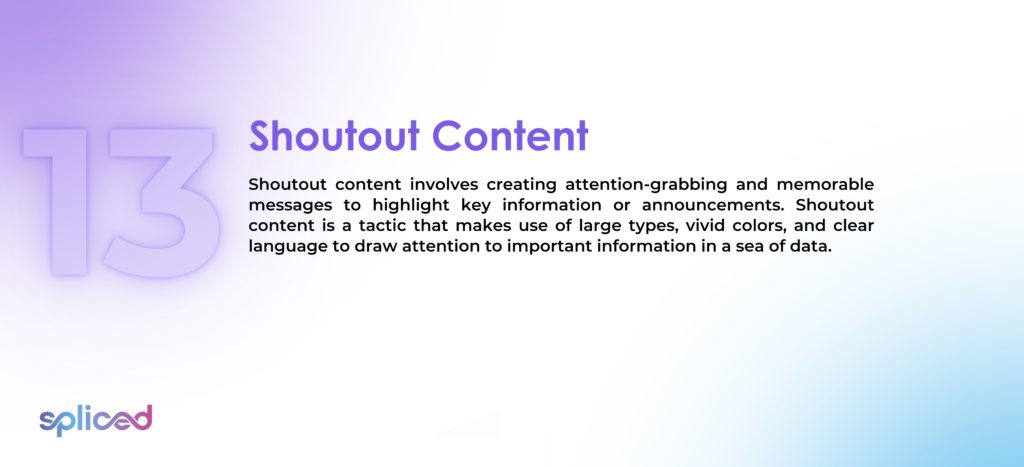
13. Shoutout Content
Shoutout content involves creating attention-grabbing and memorable messages to highlight key information or announcements. Shoutout content is a tactic that makes use of large types, vivid colors, and clear language to draw attention to important information in a sea of data.
Shoutout content is short, aesthetically appealing messaging intended to emphasize important information. Shoutout content quickly and successfully grabs the audience’s attention.
Shoutout content’s main objective is to bring instant attention to important details, such as sales, events, or important updates. Important information becomes instantly obvious when presented in bold fonts, contrasting colors, and clear wording.
Shoutout content uses design concepts to provide visual contrast and make the material being emphasized stand out. Shoutout content is accomplished by drawing the viewer’s attention to the main message through the use of bold colors, larger fonts, and inventive layouts.
Shoutout content ensures that important information is not missed to improve communication effectiveness. Shoutout content enhances audience engagement and stimulates speedy action, whether it’s making a purchase, signing up for something, or adhering to a particular call to action.
Shoutout content has an outstanding ability to grab attention due to its eye-catching design. The use of bold typeface and vibrant color contrasts adds to its attractiveness and vastly improves readability. The concise format in which shoutout content is presented facilitates rapid assimilation of critical information, allowing audiences to grasp key details without unnecessary delays.
Shoutout content loses some of its intended impact if used too frequently because audiences grow numb to its arresting visual cues. The precise balance of design elements is essential. Poor design decisions produce a jumbled or perplexing message, which makes communication ineffective. It is essential to acknowledge that shoutout content thrives when delivering succinct information. Attempting to convey intricate or elaborate details through shoutout content leads to a loss of clarity and effectiveness.
For example, a website for a clothes store with a catchy banner announcing “FLASH SALE: 50% OFF ALL ITEMS TODAY ONLY!” The words “FLASH SALE” are presented in huge, strong characters on a contrasting background, with the rest of the message providing more information. Visitors are immediately alerted to the limited-time deal with the shoutout content, encouraging them to learn more about the promotion.
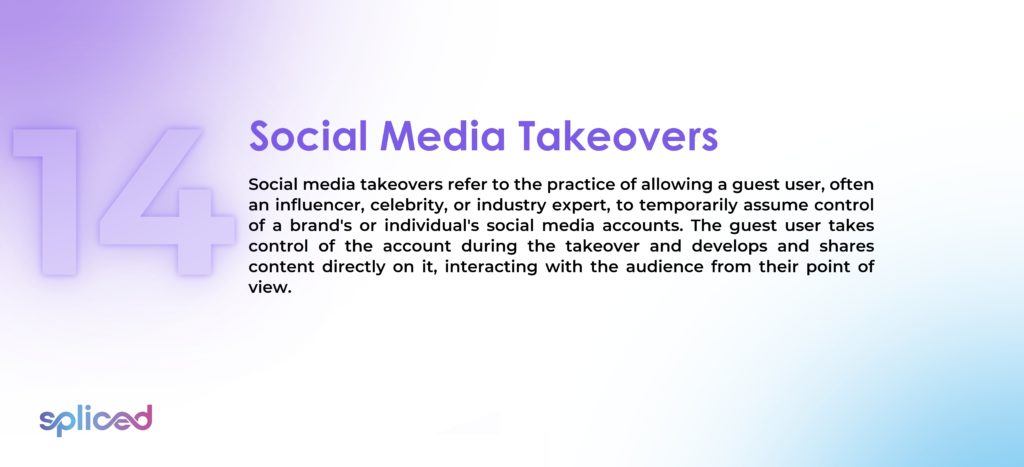
14. Social Media Takeovers
Social media takeovers refer to the practice of allowing a guest user, often an influencer, celebrity, or industry expert, to temporarily assume control of a brand’s or individual’s social media accounts. The guest user takes control of the account during the takeover and develops and shares content directly on it, interacting with the audience from their point of view.
Social media takeovers are distinguished by their temporary nature and the participation of an outside user who adds their distinct identity and audience to the account they are taking over.
The hosting account gives the guest user temporary access. The guest user creates and publishes content, engaging with the audience already there and perhaps luring in new ones. Social media takeovers are utilized to inject innovation and diversity into the account, encouraging engagement and a sense of freshness.
Social media takeovers give an account a fresh life, draw in a different audience, and increase engagement. They enable collaboration and cross-promotion, allowing the host and guest users to reach each other’s audiences. Social media takeovers provide the audience with beneficial networking opportunities and fresh perspectives.
The advantages of social media takeovers are enhanced follower growth, expanded reach, cross-promotion, fresh content, audience diversification, and increased engagement.
Disadvantages include the risk of content not aligning with the brand’s image, losing control of the account during the takeover, and requiring meticulous user screening of visitors to ensure consistency with the host’s beliefs and goals.
For example, a fashion business invites a well-known influencer to take control of its Instagram account for a day during a special event or product launch. Influencers provide material that shows their style and interactions with brands’ products, providing followers with a fresh and intriguing viewpoint. Social media takeovers increase engagement, followers, and enthusiasm for the brand’s products.
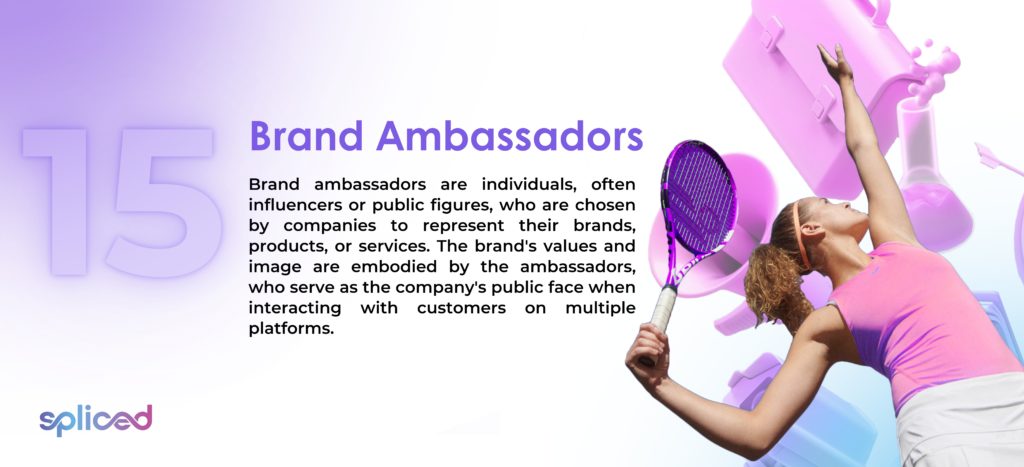
15. Brand Ambassadors
Brand ambassadors are individuals, often influencers or public figures, who are chosen by companies to represent their brands, products, or services. The brand’s values and image are embodied by the ambassadors, who serve as the company’s public face when interacting with customers on multiple platforms.
Brand ambassadors must have credibility, reach, and compatibility with the business’s identity. Brand ambassadors use their personal platforms to honestly promote the brand, building a sense of trust and connection with their audience.
Companies choose brand ambassadors based on their suitability for the brand’s target market and compatibility with its values. Ambassadors frequently produce material that promotes the brand through social media updates, blog posts, videos, or public appearances at events. The exposure helps in extending the visibility and appeal of the brand.
Partnerships with brand ambassadors result in heightened credibility, broader audience engagement, and higher brand exposure. Companies connect with new markets, engage with potential clients, and produce genuine testimonials that appeal to consumers by using the power of ambassadors.
Brand ambassadors help to humanize and make the brand seem more approachable. Their established fan following results in quick exposure, and their support gives the brand’s messaging legitimacy. Using ambassador partnerships in conventional advertising helps companies save money.
Choosing the incorrect ambassador backfires if their character or values contrast with the values of the brand. Developing a solid ambassador-brand relationship takes time, and results are not seen right away. Another danger is becoming overly dependent on an ambassador’s standing.
An example of a successful brand ambassador partnership is Nike’s collaboration with basketball superstar Michael Jordan. Nike’s partnership with Jordan has positioned the company as an athletic clothing and footwear pioneer. Michael Jordan’s skills on the field and charismatic personality complemented Nike’s “Just Do It” motto, resulting in a successful connection that has lasted for many years and continues to impact the sports and fashion worlds.

What is Influencer Marketing?
Influencer marketing is a strategic approach to brand promotion that involves collaborating with individuals who have a significant and engaged online following, often within specific niches or industries. Influencers use their social media platforms, knowledge, and reputation to produce and distribute content that advertises goods, services, or brands. Influencer marketing capitalizes on influencers’ ability to engage authentically with their audience, affecting purchasing decisions and brand perception.
Influencer marketing is based on the notion that consumers are more inclined to trust suggestions from people they want and relate to than traditional advertising. Brands access pre-existing communities that influencers have built by collaborating with them, giving them access to a highly engaged and focused audience. Influencers produce content that effortlessly combines brand messaging with product evaluations, how-to videos, unboxings, and lifestyle posts, successfully showing the products in real-world situations.
Influencer marketing expands the brand’s visibility and reach and benefits from the authority, sincerity, and closeness of the influencers’ relationships with their followers. Influencer marketing has consequently emerged as a crucial tactic in the contemporary marketing environment, bridging the gap between businesses and customers more personally and naturally.
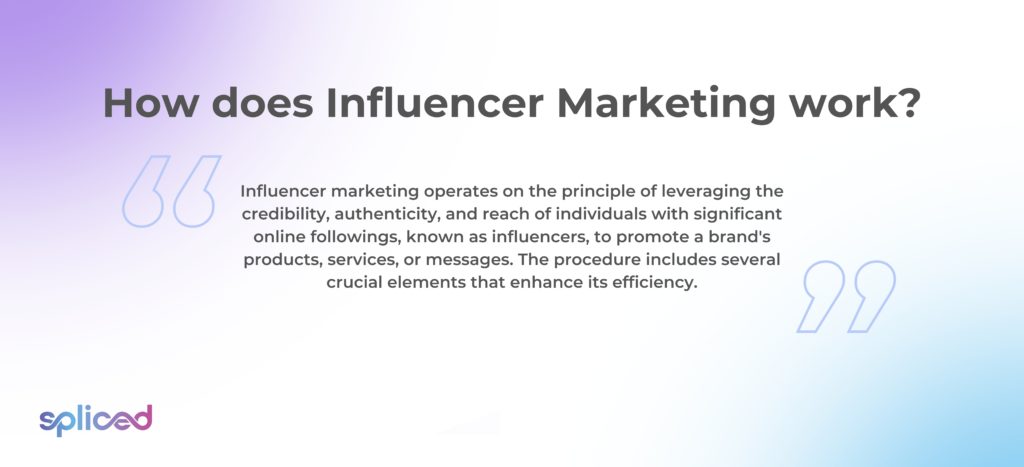
How does Influencer Marketing work?
Influencer marketing operates on the principle of leveraging the credibility, authenticity, and reach of individuals with significant online followings, known as influencers, to promote a brand’s products, services, or messages. The procedure includes several crucial elements that enhance its efficiency.
Brands start influencer marketing initiatives by choosing influencers whose audience is similar to their own. Influencer marketing entails investigating influencers’ specializations, demographics, engagement metrics, and values to ensure a good fit. Brands negotiate agreements that specify the goals of the campaign, the terms of payment, and the accepted types of content after selecting the right influencers.
The brand’s message or offerings are incorporated into the material by influencers to appeal to their audience. The content is presented in various ways, including blog posts, videos, live streaming, and blog articles. The influencer’s personal touch and sincere endorsement make the campaign more real, increasing its impact.
The influencer distributes the material on all of their platforms, which allows it to get in front of their audience and encourages interaction in the form of likes, comments, shares, and clicks. The interactions are more likely to lead to action because the influencer and their followers already know and trust each other. The marketing message is more persuasive when the influencer relates personal stories and real-world context.
Brands monitor and assess campaign effectiveness using metrics, including engagement rates, click-through rates, and conversions. The influencer marketing process continues with content development. The data explains the campaign’s accomplishments and directs future tactics. Influencer collaborations frequently go beyond one-off initiatives, with marketers fostering continuing connections to establish a dependable and long-lasting presence in the influencer’s sphere.
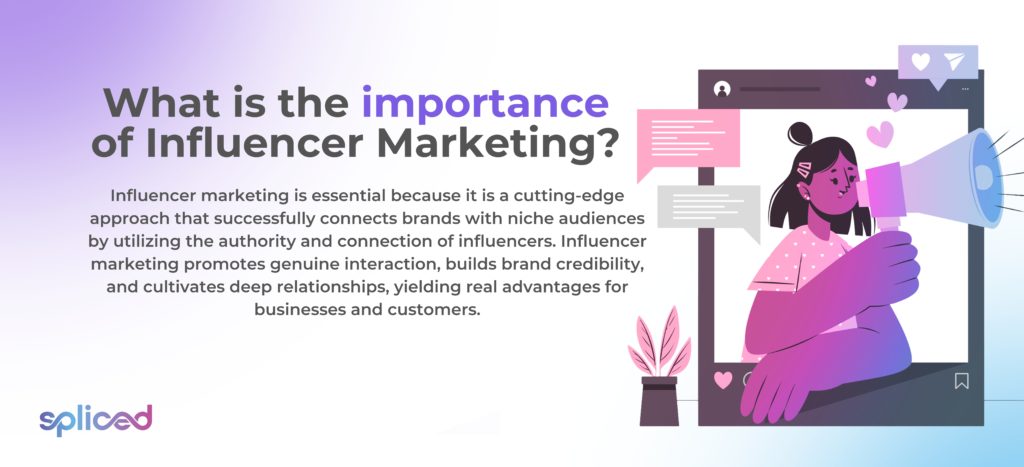
What is the importance of Influencer Marketing?
Influencer marketing is essential because it is a cutting-edge approach that successfully connects brands with niche audiences by utilizing the authority and connection of influencers. Influencer marketing promotes genuine interaction, builds brand credibility, and cultivates deep relationships, yielding real advantages for businesses and customers.
Influencer marketing distinguishes itself by allowing firms to capitalize on influencers’ existing rapport with their followers at a time when customers are increasingly seeking authenticity and a personal connection. Influencers have built devoted groups based on similar principles, experiences, and interests. Influencers’ followers are more likely to trust a business or product when they advocate it to them, as opposed to when they advertise it.
Influencer marketing strategies increase brand visibility across digital platforms and boost engagement. Influencers’ extensive reach across social media, blogs, videos, and other platforms enables marketers to reach audiences who are difficult to contact. The interaction sparked by influencers’ material has viral effects, disseminating brand messaging throughout their target audiences.
The ability of influencer marketing to alter consumer views and preferences emphasizes influencer marketing’s significance. Influencers offer new goods or services through their trustworthy recommendations, inform audiences, and even change their preconceived notions.
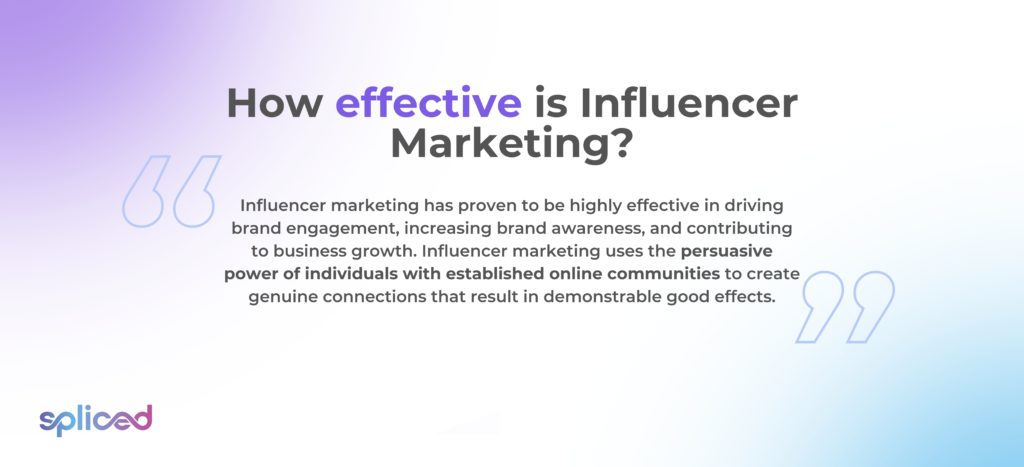
How effective is Influencer Marketing?
Influencer marketing has proven to be highly effective in driving brand engagement, increasing brand awareness, and contributing to business growth. Influencer marketing uses the persuasive power of individuals with established online communities to create genuine connections that result in demonstrable good effects.
The effectiveness of influencer marketing is demonstrated by its capacity to produce better engagement rates than traditional types of advertising. The number of likes, comments, and shares that an influencer’s post receives indicates how engaged and active their audience is. Influencer campaigns generate an average engagement rate of 5.7%, much beyond the 2-3% standard for other digital advertising techniques, according to a report by Influencer Marketing Hub.
Influencer marketing results in measurable business growth outcomes, including higher sales and conversion rates. Mediakix found that approximately 80% of marketers believe influencer marketing is successful for increasing sales, underscoring the importance of such a strategy to businesses’ bottom lines. A more appealing call to action results in a greater conversion rate when influencers have a personal connection with their audience.
Influencer marketing is one of the most effective ways to expand a brand by reaching out to new, targeted audiences. Influencers frequently target particular niches, enabling firms to connect with customers who are sincere about their offerings. Influencer marketing results in more effective client acquisition by lowering the amount of money wasted on promoting to disinterested people.
Influencer marketing succeeds at raising brand awareness. Brands gain exposure to their followers who are already interested in the niche by working with influencers who have established themselves as authorities or enthusiasts in their industry. The influencer’s endorsement enhances opportunities for followers to learn about and interact with the company, which has a snowball effect.
Influencer-endorsed ads that went viral are examples of how effective it is to raise brand awareness. Influencers trigger a cascade of shares, mentions, and discussions on social media platforms when they produce interesting content that connects with their audience and supports the brand’s message. A ripple effect amplifies the brand’s message exponentially, which significantly increases brand visibility.
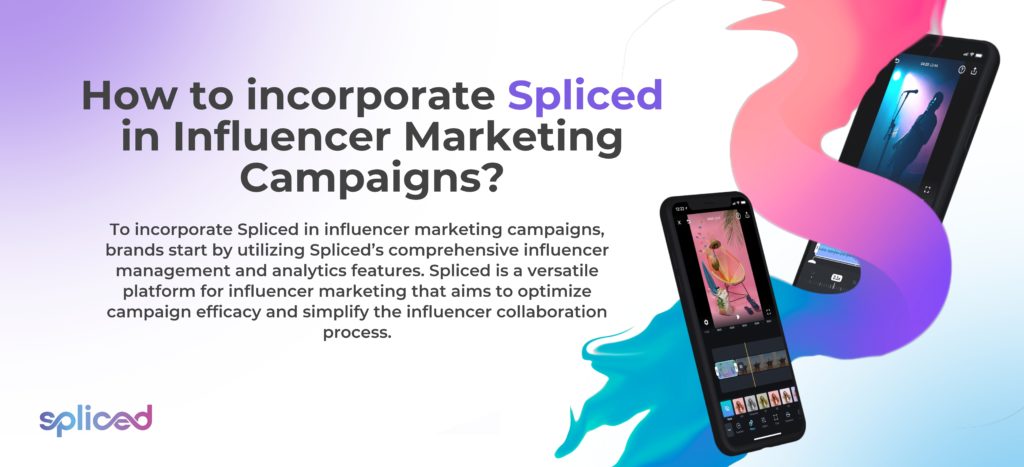
How to incorporate Spliced in Influencer Marketing Campaigns?
To incorporate Spliced in influencer marketing campaigns, brands start by utilizing Spliced’s comprehensive influencer management and analytics features. Spliced is a versatile platform for influencer marketing that aims to optimize campaign efficacy and simplify the influencer collaboration process.
Businesses utilize Spliced to find influencers that are right for their campaigns. Brands use Spliced’s influencer discovery tools to find influencers that fit particular criteria, including audience demographics, engagement rates, niches, and past partnerships. It guarantees businesses collaborate with influencers that complement their brand and target market.
Spliced provides outreach and communication features after influencers are chosen. Influencers are reached with specific campaign objectives and expectations by brands using the platform to negotiate terms of partnership and offer proposals for collaboration. Spliced helps with contract and payment facilitation, improving the effectiveness and transparency of the collaborative process.
Spliced offers performance tracking and real-time information during the campaign. Key performance indicators that businesses track include engagement rates, reach, impressions, and conversions brought about by the influencer’s material. The information guarantees that the campaign is in line with the objectives of the brand and enables continuous optimization.
The reporting and analytics features of Spliced remain active with the campaign. Detailed performance reports allow brands to evaluate the influencer marketing campaign’s overall impact and return on investment. These data help organizations fine-tune their influencer marketing approach and make well-informed decisions about future influencer collaborations.
Spliced provides influencer finding, outreach, campaign management, real-time analytics, and post-campaign analysis, which are easily integrated into influencer marketing campaigns. Businesses maximize their influencer marketing efforts, improve brand recognition, and create genuine connections with their target audience through reliable influencers by utilizing Spliced’s comprehensive suite of tools.
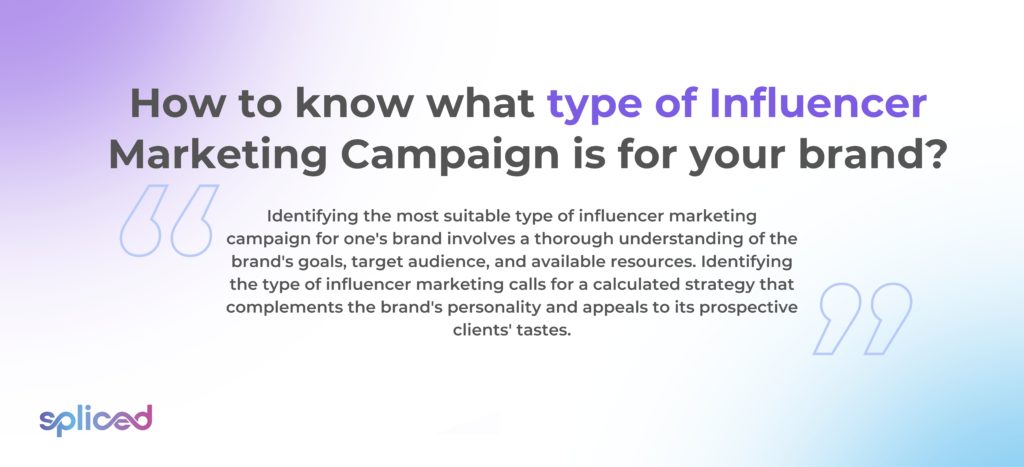
How to know what type of Influencer Marketing Campaign is for your brand?
Identifying the most suitable type of influencer marketing campaign for one’s brand involves a thorough understanding of the brand’s goals, target audience, and available resources. Identifying the type of influencer marketing calls for a calculated strategy that complements the brand’s personality and appeals to its prospective clients’ tastes.
Companies’ unique goals must determine the chosen influencer marketing strategy. A series of sponsored content posts or a brand ambassadorship is successful if the company aims to raise brand recognition among a large audience. Working with specialized niche influencers in one’s business provides more targeted exposure if one wants to draw attention to a product’s distinctive qualities.
Understanding the company’s target audience is a crucial component. Investigate their tastes, habits, and the channels they use to guarantee the advertisement reaches them successfully. For example, visual advertising, including photo-sharing or Instagram Stories, is successful if the target demographic is active on that platform. Partnering with influencers who produce in-depth blog posts or YouTube videos is beneficial if the audience responds better to such content.
The available resources have a significant impact on finances and creativity. More money is needed to invest in elaborate campaigns than simple sponsored posts, such as product giveaways, competitions, or influencer-hosted events. The type of influencer one works with must be consistent with the brand’s concept and budget.
Trial and error provide valuable insights, but relying primarily on the method results in inefficiencies. One must build initial campaigns on in-depth analysis, industry benchmarks, and trends. Monitoring metrics such as engagement, reach, and conversions helps businesses determine the effectiveness of each campaign. They improve their tactics over time based on the knowledge they’ve gained, but starting with a well-thought-out plan produces more reliable and advantageous results.
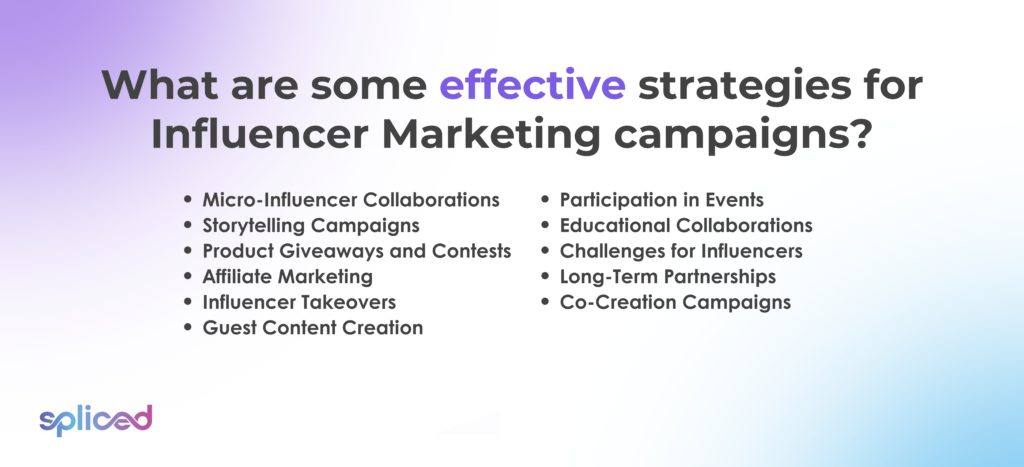
What are some effective strategies for Influencer Marketing campaigns?
Listed below are some of the effective strategies for influencer marketing campaigns.
- Micro-Influencer Collaborations: Collaborate together with micro-influencers who have tiny but highly engaged fan bases. Their deep relationships with their audience and genuineness result in more sincere recommendations and better conversion rates.
- Storytelling Campaigns: Create compelling narratives that are consistent with the company’s brand message and ask influencers to share their own experiences with their goods or services. The audience responds strongly to the emotional connection, making the advertising memorable.
- Product Giveaways and Contests: Organize giveaways or contests in collaboration with influencers, encouraging their followers to take part for an opportunity to win their products. The participants in the campaign spread the campaign, which creates buzz and enhances brand visibility.
- Affiliate Marketing: Pay influencers a percentage of sales made through their special affiliate link. Paying encourages them to aggressively market business goods and results in successful long-term alliances.
- Influencer Takeovers: Allow influencers to control the brand’s social media pages for a single day or a particular occasion. Allowing influencers to take over generates new content, increases interaction, and gives their fans an insight into their company.
- Guest Content Creation: Invite influencers to create guest content for the brand’s blog, YouTube channel, or podcast. Inviting influencers provides a cross-promotional opportunity and introduces the company to its audience.
- Participate in Events: Collaborate with influencers to attend or organize events relevant to their industry. Their presence draws followers and offers immediate exposure.
- Educational Collaborations: Work with influencers to provide tutorials, reviews, or other educational content that informs their audience about the advantages and features of the company’s goods and services.
- Challenges for Influencers: Develop relevant challenges to the brand and invite influencers to participate so they interact with their audience. A flood of user-generated content and brand interactions result from the strategy.
- Long-Term Partnerships: Establish enduring connections with influencers who sincerely share the brand’s values. Long-term collaborations result in dependable exposure and a genuine relationship with their audience.
- Co-Creation Campaigns: Co-creation campaigns are one of the strategies for Influencer Marketing campaigns. Involve influencers in the development process so they offer suggestions on campaign ideas, content ideas, or product designs. The cooperative approach increases their commitment to the campaign’s success.
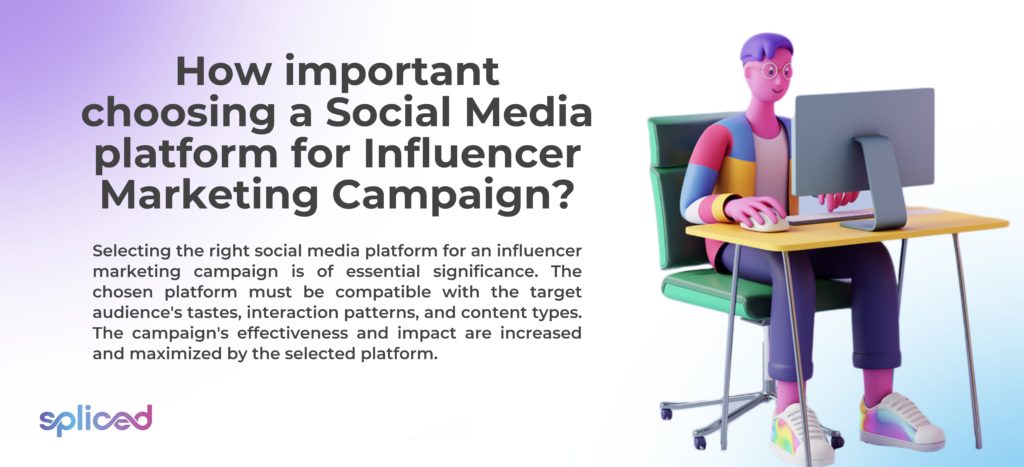
How important choosing a Social Media platform for Influencer Marketing Campaign?
Selecting the right social media platform for an influencer marketing campaign is of essential significance. The chosen platform must be compatible with the target audience’s tastes, interaction patterns, and content types. The campaign’s effectiveness and impact are increased and maximized by the selected platform.
Users of social media on various platforms have different demographics and behaviors. For example, younger viewers prefer Instagram and TikTok, whereas older audiences prefer Facebook and LinkedIn. One must select a platform where influencers’ content is most relevant and interesting by being aware of the demographics and preferences of the viewers.
Different social media platforms cater to specific types of content. Instagram strongly emphasizes visual material, making it the perfect platform for presenting lifestyle goods and visually appealing experiences. Twitter provides immediate updates and engagement, while YouTube is great for longer-form video content and tutorials. The campaign integrates effortlessly into consumers’ feeds if the content style aligns with the platform’s advantages.
There are many benefits to using social media platforms for influencer marketing. Social media platforms provide accurate targeting based on demographics, ensuring campaigns successfully reach the target population. Real-time interaction through comments and messaging promotes community building and authenticity. Choosing the appropriate social media marketing type depends on the company’s goals and the specific strategy they wish to employ within their influencer marketing campaign.
Visual channels, including Instagram and Pinterest, enhance campaigns for aesthetically appealing items. Stories on websites such as Facebook and Instagram allow for immersive storytelling. Effective video material is found on platforms such as TikTok and YouTube. Hashtags must be used wisely to improve content discovery. Features that encourage sharing amplify influence and result in viral consequences. Social media platforms foster a space where engagement, authenticity, and content intersect to generate effective marketing.
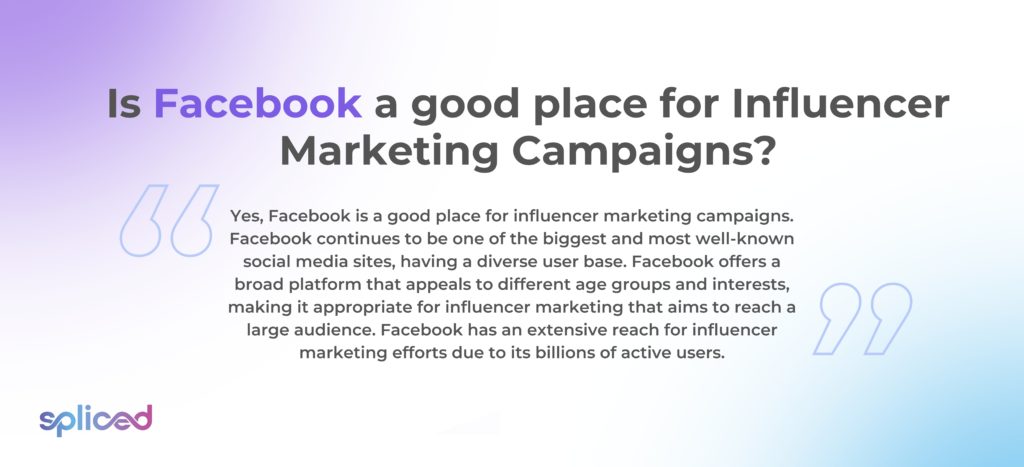
Is Facebook a good place for Influencer Marketing Campaigns?
Yes, Facebook is a good place for influencer marketing campaigns. Facebook continues to be one of the biggest and most well-known social media sites, having a diverse user base. Facebook offers a broad platform that appeals to different age groups and interests, making it appropriate for influencer marketing that aims to reach a large audience. Facebook has an extensive reach for influencer marketing efforts due to its billions of active users.
Facebook offers capabilities that enable exact audience segmentation based on demographics, interests, activities, and more. One such feature is its advanced ad targeting opportunities. Facebook’s targeted approach improves the effectiveness of influencer campaigns by delivering content to the appropriate audience, which boosts engagement and conversions.
The platform’s interactive features, such as comments, likes, and shares, make real-time interaction between influencers and their followers. The platform promotes a feeling of belonging and authenticity, which strengthens the influencer’s authority and the campaign’s impact.
Influencers publish a range of material forms using various types of campaigns, such as Facebook, including photographs, videos, and live streams, due to the social network’s multimedia features. The adaptability allows for various storytelling techniques and increases innovative and captivating marketing opportunities.
Is Influencer Marketing Campaign on Instagram effective?
Yes, influencer marketing campaigns on Instagram are highly effective. Instagram has become one of the most popular and visually-focused social media channels, which makes it the perfect medium for influencer marketing. Instagram has a sizable and active audience with more than a billion active users, giving businesses plenty of opportunities to engage with their target markets.
Instagram’s emphasis on visual content, such as images, videos, and Stories, enables creative and engaging storytelling. Influencers easily include brand messages, goods, and services in their content to give their audience a more genuine and relatable feel. Higher engagement rates compared to traditional advertising are mostly due to that authenticity.
Instagram’s user base comprises people of all ages, but it attracts most younger audiences, making it useful for businesses aiming to market to millennials and Gen Z consumers. Theaudiences frequently look to influencers for product recommendations and are more open to their endorsements.
Influencer activities improve discoverability and engagement with Instagram features such as hashtags, geotags, and user mentions. The exposure of brands is increased by strategically utilizing the features to expand the reach of influencer marketing beyond their direct following.
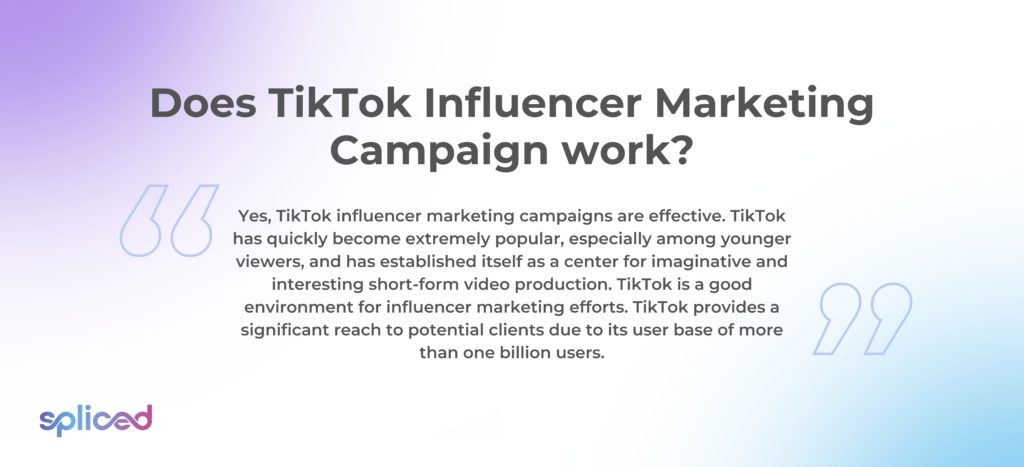
Does TikTok Influencer Marketing Campaign work?
Yes, TikTok influencer marketing campaigns are effective. TikTok has quickly become extremely popular, especially among younger viewers, and has established itself as a center for imaginative and interesting short-form video production. TikTok is a good environment for influencer marketing efforts. TikTok provides a significant reach to potential clients due to its user base of more than one billion users.
Influencer marketing is compatible with the platform’s focus on authentic user-generated content. The ability of TikTok influencers to produce interesting and relatable content that connects with their fans increases engagement rates and an opportunity for the material to go viral.
Smaller influencers become more visible and powerful through TikTok’s algorithm, which prioritizes content interaction over follower count. It equalizes the playing field and allows brands to work with various influencers.
Influencer-driven campaigns have an opportunity to gain popularity and visibility very quickly due to TikTok’s difficulties, trends, and viral nature. Brands capitalize on the present momentum to raise brand awareness when influencers take part in such difficulties or produce content that aligns with popular trends.
